Project Analysis Report: Newman PLC Capital Structure Analysis
VerifiedAdded on 2022/08/20
|15
|3401
|12
Report
AI Summary
This report provides a comprehensive analysis of corporate finance principles, focusing on capital structure, cost of capital, and project appraisal methods. It begins by evaluating the arguments surrounding Newman PLC's capital structure, considering the implications of issuing preference shares or debentures, and discussing the views of Modigliani and Miller. The report then delves into project appraisal techniques, including Net Present Value (NPV) and Internal Rate of Return (IRR), emphasizing the importance of economic feasibility, market conditions, and cash flow analysis. It also highlights the significance of scenario, stress, and simulation analyses in enhancing the evaluation process. The report concludes by examining the factors that affect a company when raising additional debt, such as the increased risk for existing debt and equity holders. This report offers a detailed overview of essential concepts in corporate finance, providing insights into decision-making related to capital structure and investment projects.

Running head: PROJECT ANALYSIS
Project Analysis
Name of the Student:
Name of the University:
Author Note:
Project Analysis
Name of the Student:
Name of the University:
Author Note:
Paraphrase This Document
Need a fresh take? Get an instant paraphrase of this document with our AI Paraphraser
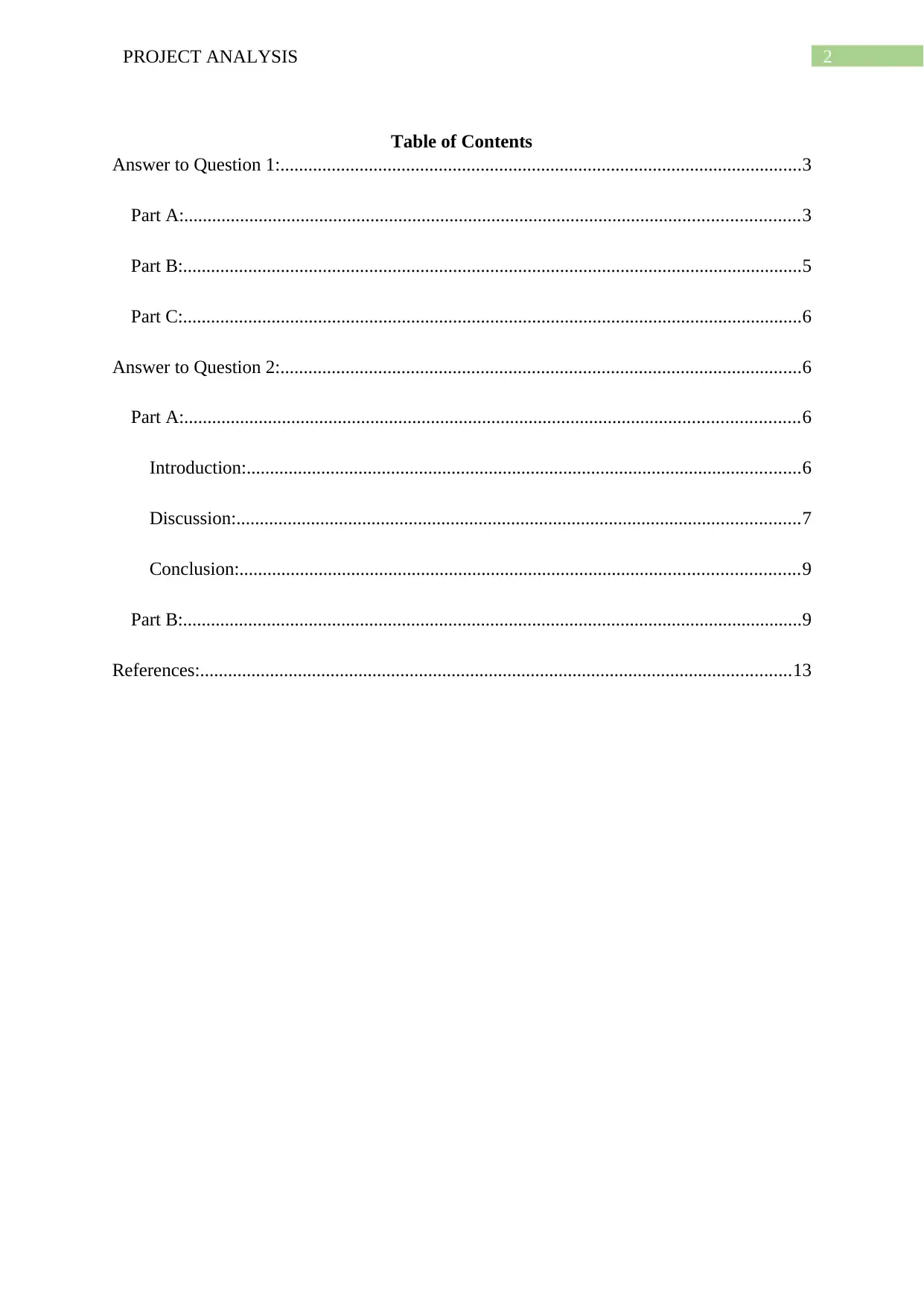
2PROJECT ANALYSIS
Table of Contents
Answer to Question 1:................................................................................................................3
Part A:....................................................................................................................................3
Part B:.....................................................................................................................................5
Part C:.....................................................................................................................................6
Answer to Question 2:................................................................................................................6
Part A:....................................................................................................................................6
Introduction:.......................................................................................................................6
Discussion:.........................................................................................................................7
Conclusion:........................................................................................................................9
Part B:.....................................................................................................................................9
References:...............................................................................................................................13
Table of Contents
Answer to Question 1:................................................................................................................3
Part A:....................................................................................................................................3
Part B:.....................................................................................................................................5
Part C:.....................................................................................................................................6
Answer to Question 2:................................................................................................................6
Part A:....................................................................................................................................6
Introduction:.......................................................................................................................6
Discussion:.........................................................................................................................7
Conclusion:........................................................................................................................9
Part B:.....................................................................................................................................9
References:...............................................................................................................................13
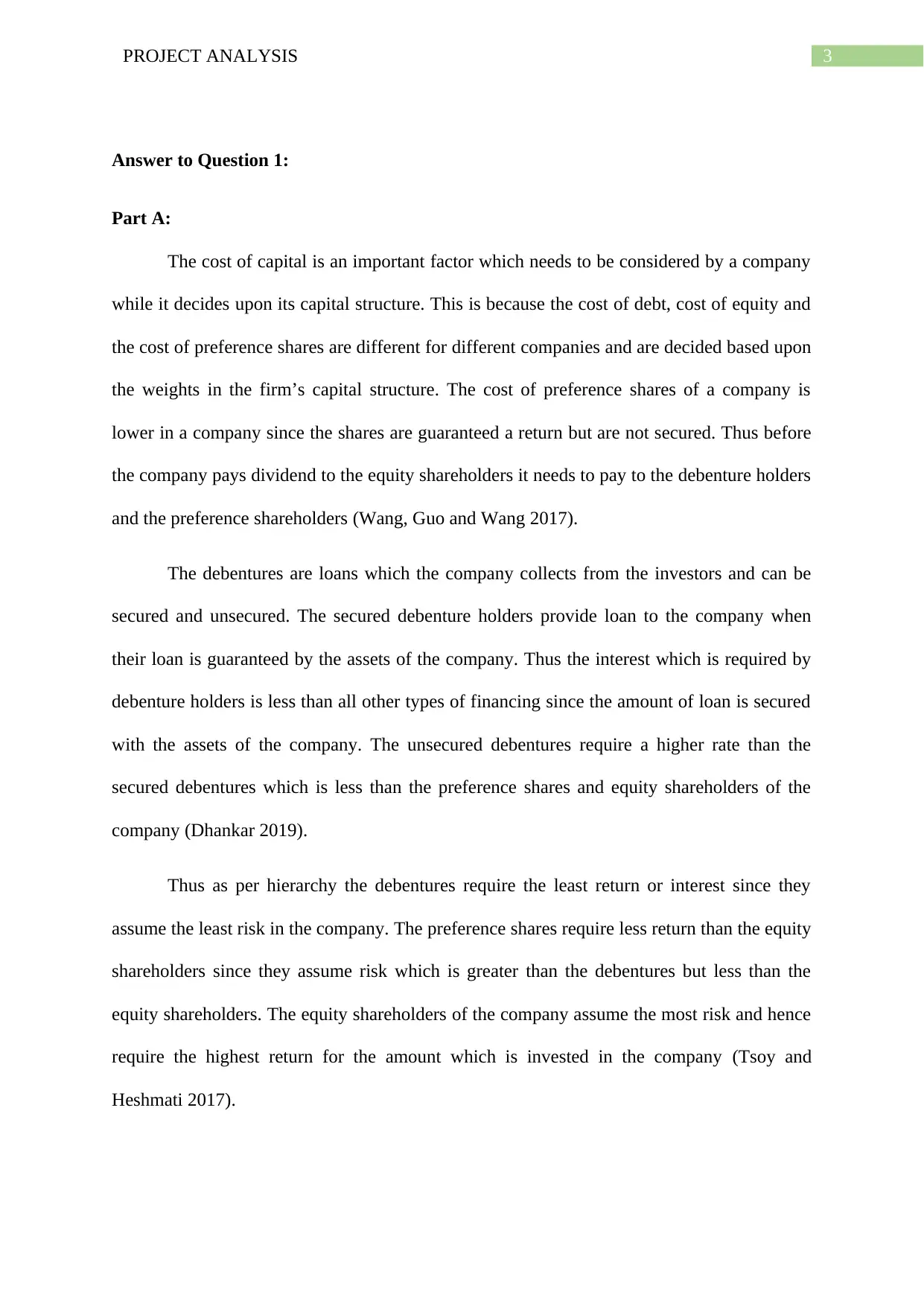
3PROJECT ANALYSIS
Answer to Question 1:
Part A:
The cost of capital is an important factor which needs to be considered by a company
while it decides upon its capital structure. This is because the cost of debt, cost of equity and
the cost of preference shares are different for different companies and are decided based upon
the weights in the firm’s capital structure. The cost of preference shares of a company is
lower in a company since the shares are guaranteed a return but are not secured. Thus before
the company pays dividend to the equity shareholders it needs to pay to the debenture holders
and the preference shareholders (Wang, Guo and Wang 2017).
The debentures are loans which the company collects from the investors and can be
secured and unsecured. The secured debenture holders provide loan to the company when
their loan is guaranteed by the assets of the company. Thus the interest which is required by
debenture holders is less than all other types of financing since the amount of loan is secured
with the assets of the company. The unsecured debentures require a higher rate than the
secured debentures which is less than the preference shares and equity shareholders of the
company (Dhankar 2019).
Thus as per hierarchy the debentures require the least return or interest since they
assume the least risk in the company. The preference shares require less return than the equity
shareholders since they assume risk which is greater than the debentures but less than the
equity shareholders. The equity shareholders of the company assume the most risk and hence
require the highest return for the amount which is invested in the company (Tsoy and
Heshmati 2017).
Answer to Question 1:
Part A:
The cost of capital is an important factor which needs to be considered by a company
while it decides upon its capital structure. This is because the cost of debt, cost of equity and
the cost of preference shares are different for different companies and are decided based upon
the weights in the firm’s capital structure. The cost of preference shares of a company is
lower in a company since the shares are guaranteed a return but are not secured. Thus before
the company pays dividend to the equity shareholders it needs to pay to the debenture holders
and the preference shareholders (Wang, Guo and Wang 2017).
The debentures are loans which the company collects from the investors and can be
secured and unsecured. The secured debenture holders provide loan to the company when
their loan is guaranteed by the assets of the company. Thus the interest which is required by
debenture holders is less than all other types of financing since the amount of loan is secured
with the assets of the company. The unsecured debentures require a higher rate than the
secured debentures which is less than the preference shares and equity shareholders of the
company (Dhankar 2019).
Thus as per hierarchy the debentures require the least return or interest since they
assume the least risk in the company. The preference shares require less return than the equity
shareholders since they assume risk which is greater than the debentures but less than the
equity shareholders. The equity shareholders of the company assume the most risk and hence
require the highest return for the amount which is invested in the company (Tsoy and
Heshmati 2017).
⊘ This is a preview!⊘
Do you want full access?
Subscribe today to unlock all pages.

Trusted by 1+ million students worldwide
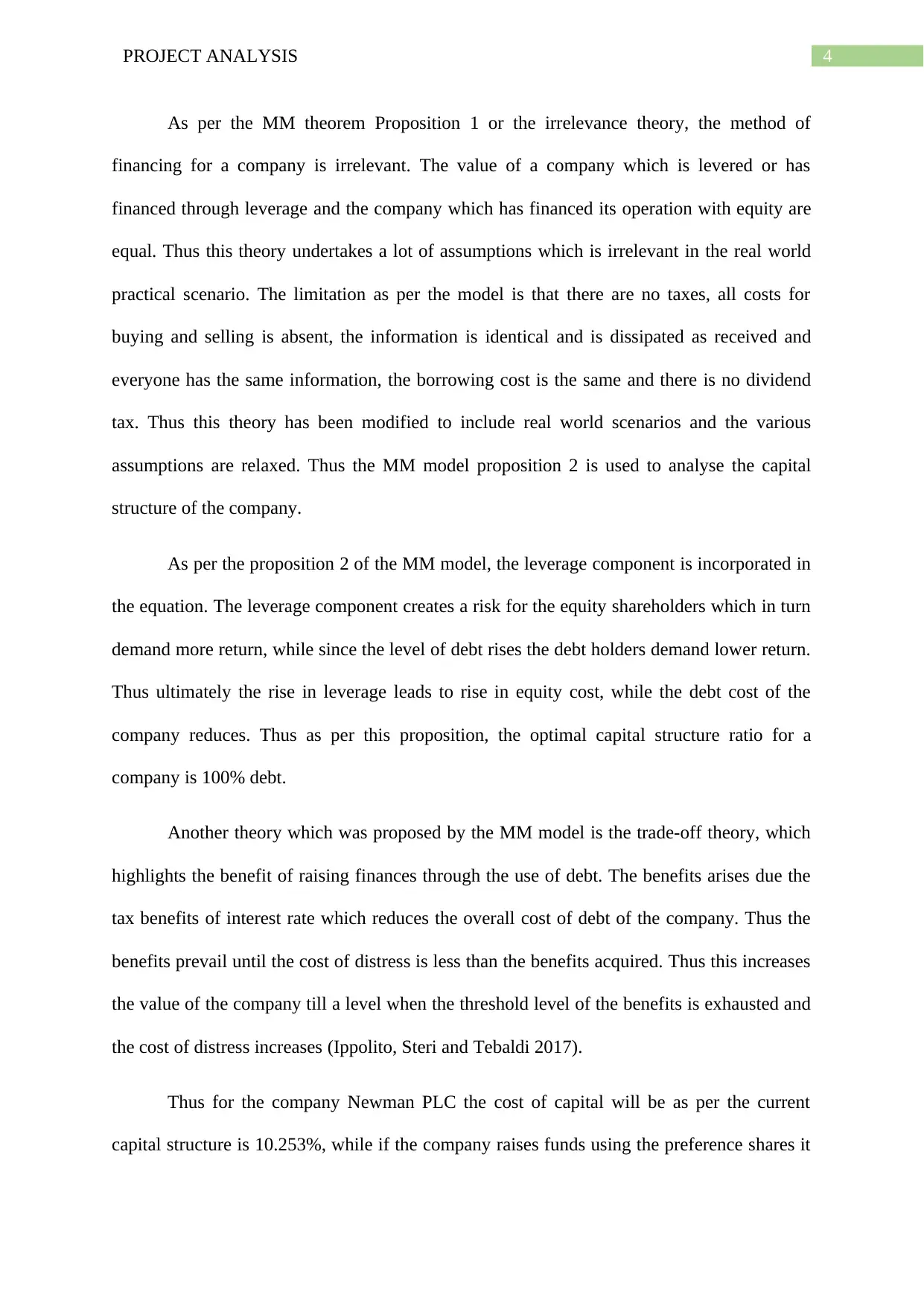
4PROJECT ANALYSIS
As per the MM theorem Proposition 1 or the irrelevance theory, the method of
financing for a company is irrelevant. The value of a company which is levered or has
financed through leverage and the company which has financed its operation with equity are
equal. Thus this theory undertakes a lot of assumptions which is irrelevant in the real world
practical scenario. The limitation as per the model is that there are no taxes, all costs for
buying and selling is absent, the information is identical and is dissipated as received and
everyone has the same information, the borrowing cost is the same and there is no dividend
tax. Thus this theory has been modified to include real world scenarios and the various
assumptions are relaxed. Thus the MM model proposition 2 is used to analyse the capital
structure of the company.
As per the proposition 2 of the MM model, the leverage component is incorporated in
the equation. The leverage component creates a risk for the equity shareholders which in turn
demand more return, while since the level of debt rises the debt holders demand lower return.
Thus ultimately the rise in leverage leads to rise in equity cost, while the debt cost of the
company reduces. Thus as per this proposition, the optimal capital structure ratio for a
company is 100% debt.
Another theory which was proposed by the MM model is the trade-off theory, which
highlights the benefit of raising finances through the use of debt. The benefits arises due the
tax benefits of interest rate which reduces the overall cost of debt of the company. Thus the
benefits prevail until the cost of distress is less than the benefits acquired. Thus this increases
the value of the company till a level when the threshold level of the benefits is exhausted and
the cost of distress increases (Ippolito, Steri and Tebaldi 2017).
Thus for the company Newman PLC the cost of capital will be as per the current
capital structure is 10.253%, while if the company raises funds using the preference shares it
As per the MM theorem Proposition 1 or the irrelevance theory, the method of
financing for a company is irrelevant. The value of a company which is levered or has
financed through leverage and the company which has financed its operation with equity are
equal. Thus this theory undertakes a lot of assumptions which is irrelevant in the real world
practical scenario. The limitation as per the model is that there are no taxes, all costs for
buying and selling is absent, the information is identical and is dissipated as received and
everyone has the same information, the borrowing cost is the same and there is no dividend
tax. Thus this theory has been modified to include real world scenarios and the various
assumptions are relaxed. Thus the MM model proposition 2 is used to analyse the capital
structure of the company.
As per the proposition 2 of the MM model, the leverage component is incorporated in
the equation. The leverage component creates a risk for the equity shareholders which in turn
demand more return, while since the level of debt rises the debt holders demand lower return.
Thus ultimately the rise in leverage leads to rise in equity cost, while the debt cost of the
company reduces. Thus as per this proposition, the optimal capital structure ratio for a
company is 100% debt.
Another theory which was proposed by the MM model is the trade-off theory, which
highlights the benefit of raising finances through the use of debt. The benefits arises due the
tax benefits of interest rate which reduces the overall cost of debt of the company. Thus the
benefits prevail until the cost of distress is less than the benefits acquired. Thus this increases
the value of the company till a level when the threshold level of the benefits is exhausted and
the cost of distress increases (Ippolito, Steri and Tebaldi 2017).
Thus for the company Newman PLC the cost of capital will be as per the current
capital structure is 10.253%, while if the company raises funds using the preference shares it
Paraphrase This Document
Need a fresh take? Get an instant paraphrase of this document with our AI Paraphraser
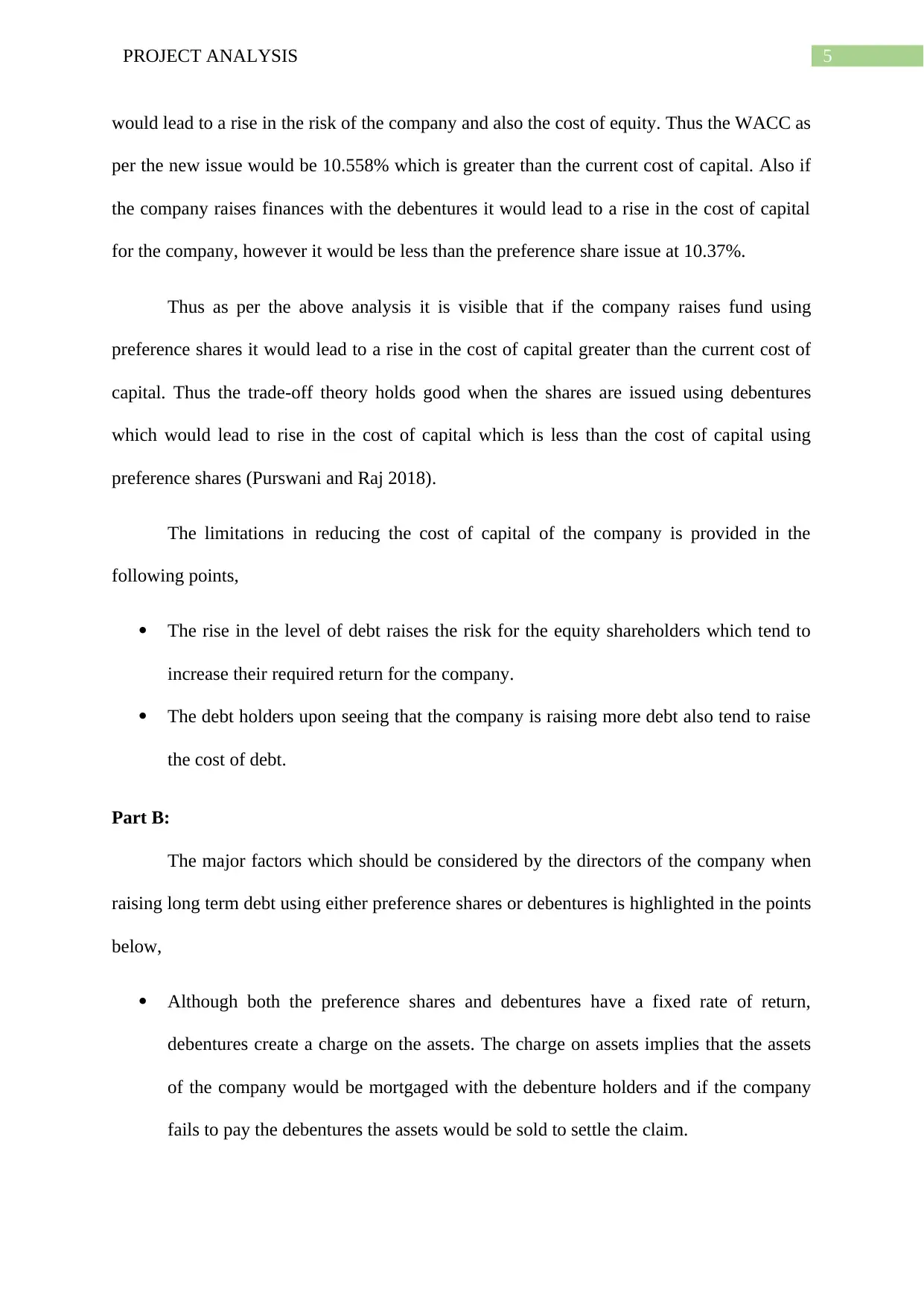
5PROJECT ANALYSIS
would lead to a rise in the risk of the company and also the cost of equity. Thus the WACC as
per the new issue would be 10.558% which is greater than the current cost of capital. Also if
the company raises finances with the debentures it would lead to a rise in the cost of capital
for the company, however it would be less than the preference share issue at 10.37%.
Thus as per the above analysis it is visible that if the company raises fund using
preference shares it would lead to a rise in the cost of capital greater than the current cost of
capital. Thus the trade-off theory holds good when the shares are issued using debentures
which would lead to rise in the cost of capital which is less than the cost of capital using
preference shares (Purswani and Raj 2018).
The limitations in reducing the cost of capital of the company is provided in the
following points,
The rise in the level of debt raises the risk for the equity shareholders which tend to
increase their required return for the company.
The debt holders upon seeing that the company is raising more debt also tend to raise
the cost of debt.
Part B:
The major factors which should be considered by the directors of the company when
raising long term debt using either preference shares or debentures is highlighted in the points
below,
Although both the preference shares and debentures have a fixed rate of return,
debentures create a charge on the assets. The charge on assets implies that the assets
of the company would be mortgaged with the debenture holders and if the company
fails to pay the debentures the assets would be sold to settle the claim.
would lead to a rise in the risk of the company and also the cost of equity. Thus the WACC as
per the new issue would be 10.558% which is greater than the current cost of capital. Also if
the company raises finances with the debentures it would lead to a rise in the cost of capital
for the company, however it would be less than the preference share issue at 10.37%.
Thus as per the above analysis it is visible that if the company raises fund using
preference shares it would lead to a rise in the cost of capital greater than the current cost of
capital. Thus the trade-off theory holds good when the shares are issued using debentures
which would lead to rise in the cost of capital which is less than the cost of capital using
preference shares (Purswani and Raj 2018).
The limitations in reducing the cost of capital of the company is provided in the
following points,
The rise in the level of debt raises the risk for the equity shareholders which tend to
increase their required return for the company.
The debt holders upon seeing that the company is raising more debt also tend to raise
the cost of debt.
Part B:
The major factors which should be considered by the directors of the company when
raising long term debt using either preference shares or debentures is highlighted in the points
below,
Although both the preference shares and debentures have a fixed rate of return,
debentures create a charge on the assets. The charge on assets implies that the assets
of the company would be mortgaged with the debenture holders and if the company
fails to pay the debentures the assets would be sold to settle the claim.
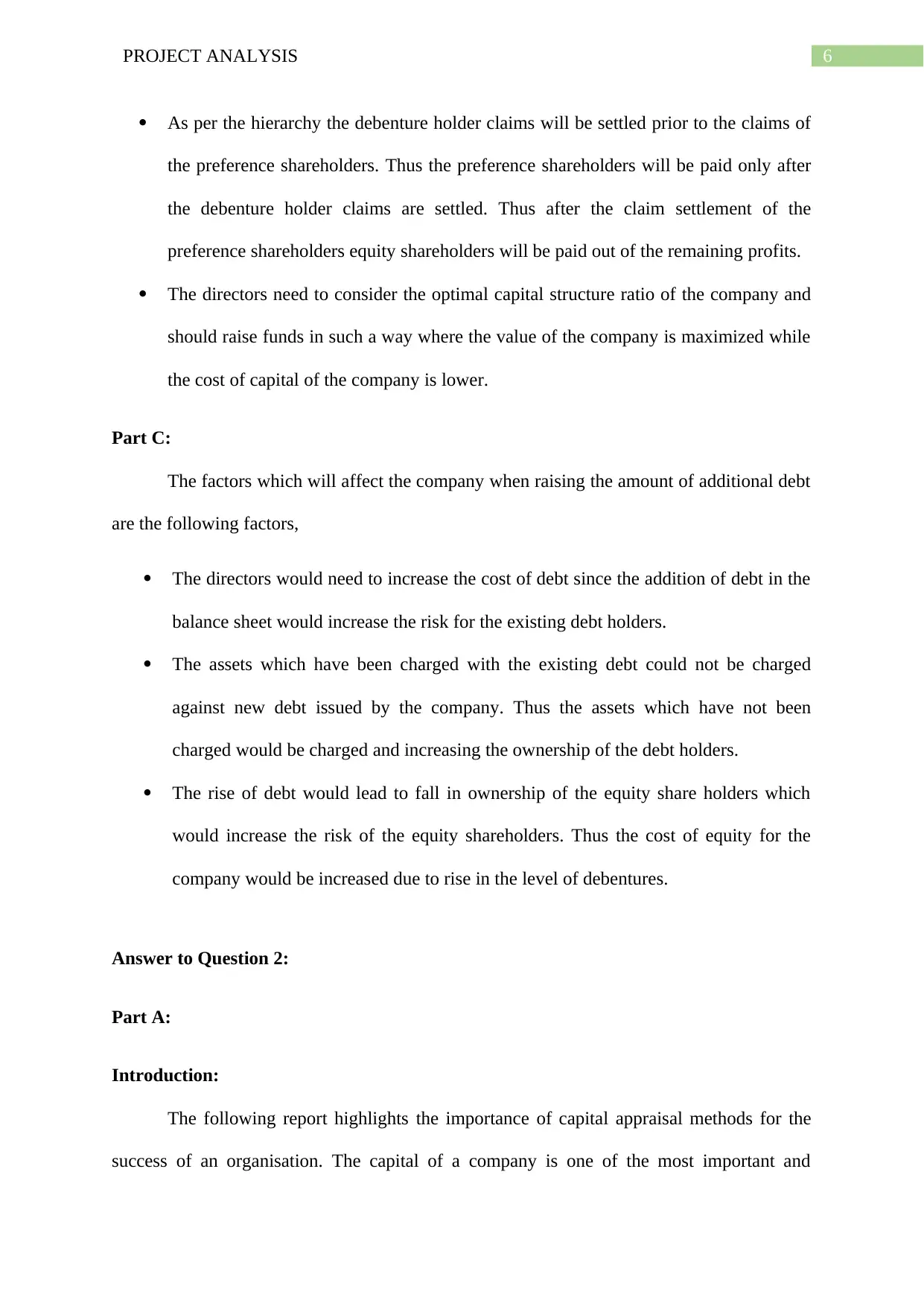
6PROJECT ANALYSIS
As per the hierarchy the debenture holder claims will be settled prior to the claims of
the preference shareholders. Thus the preference shareholders will be paid only after
the debenture holder claims are settled. Thus after the claim settlement of the
preference shareholders equity shareholders will be paid out of the remaining profits.
The directors need to consider the optimal capital structure ratio of the company and
should raise funds in such a way where the value of the company is maximized while
the cost of capital of the company is lower.
Part C:
The factors which will affect the company when raising the amount of additional debt
are the following factors,
The directors would need to increase the cost of debt since the addition of debt in the
balance sheet would increase the risk for the existing debt holders.
The assets which have been charged with the existing debt could not be charged
against new debt issued by the company. Thus the assets which have not been
charged would be charged and increasing the ownership of the debt holders.
The rise of debt would lead to fall in ownership of the equity share holders which
would increase the risk of the equity shareholders. Thus the cost of equity for the
company would be increased due to rise in the level of debentures.
Answer to Question 2:
Part A:
Introduction:
The following report highlights the importance of capital appraisal methods for the
success of an organisation. The capital of a company is one of the most important and
As per the hierarchy the debenture holder claims will be settled prior to the claims of
the preference shareholders. Thus the preference shareholders will be paid only after
the debenture holder claims are settled. Thus after the claim settlement of the
preference shareholders equity shareholders will be paid out of the remaining profits.
The directors need to consider the optimal capital structure ratio of the company and
should raise funds in such a way where the value of the company is maximized while
the cost of capital of the company is lower.
Part C:
The factors which will affect the company when raising the amount of additional debt
are the following factors,
The directors would need to increase the cost of debt since the addition of debt in the
balance sheet would increase the risk for the existing debt holders.
The assets which have been charged with the existing debt could not be charged
against new debt issued by the company. Thus the assets which have not been
charged would be charged and increasing the ownership of the debt holders.
The rise of debt would lead to fall in ownership of the equity share holders which
would increase the risk of the equity shareholders. Thus the cost of equity for the
company would be increased due to rise in the level of debentures.
Answer to Question 2:
Part A:
Introduction:
The following report highlights the importance of capital appraisal methods for the
success of an organisation. The capital of a company is one of the most important and
⊘ This is a preview!⊘
Do you want full access?
Subscribe today to unlock all pages.

Trusted by 1+ million students worldwide
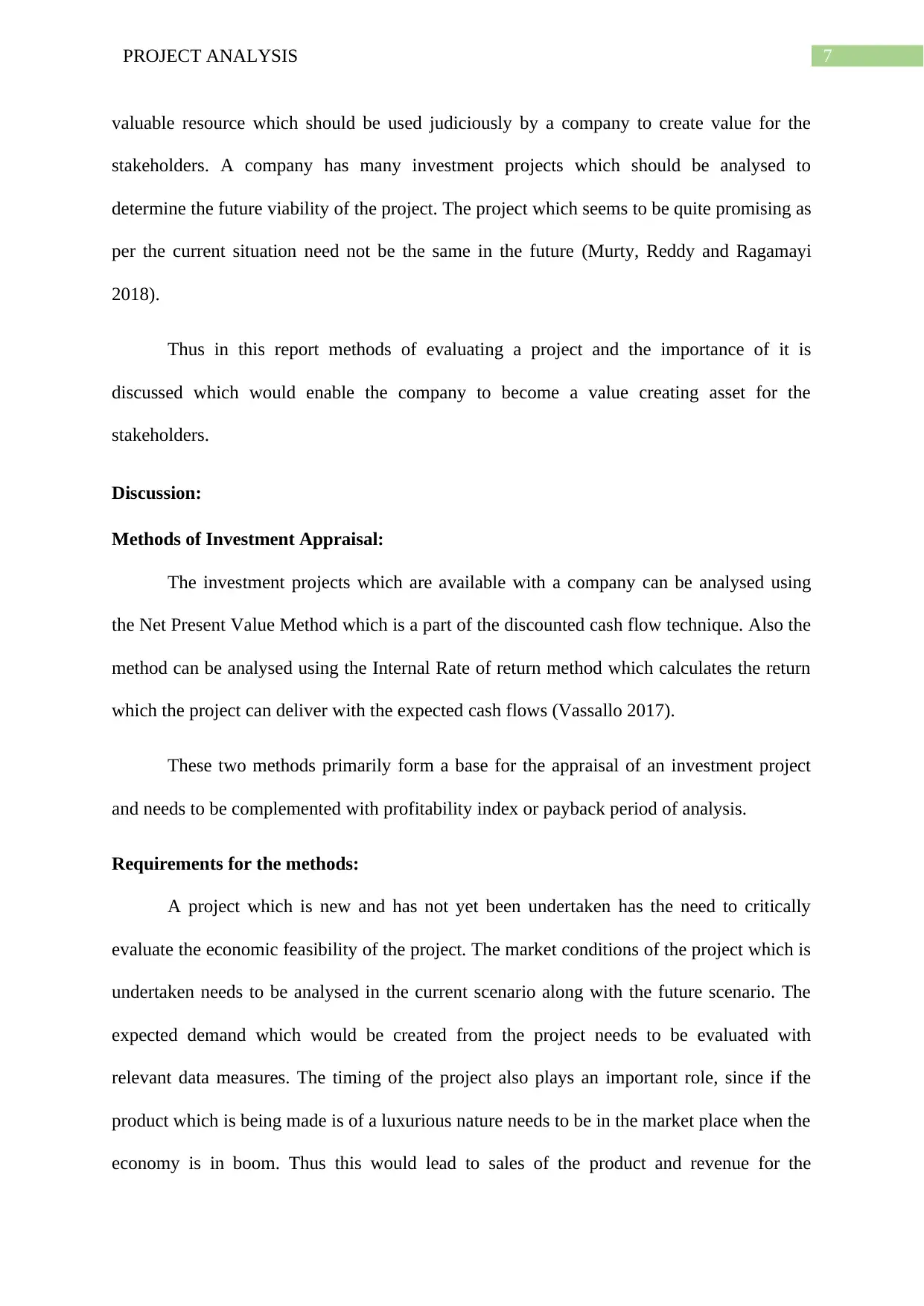
7PROJECT ANALYSIS
valuable resource which should be used judiciously by a company to create value for the
stakeholders. A company has many investment projects which should be analysed to
determine the future viability of the project. The project which seems to be quite promising as
per the current situation need not be the same in the future (Murty, Reddy and Ragamayi
2018).
Thus in this report methods of evaluating a project and the importance of it is
discussed which would enable the company to become a value creating asset for the
stakeholders.
Discussion:
Methods of Investment Appraisal:
The investment projects which are available with a company can be analysed using
the Net Present Value Method which is a part of the discounted cash flow technique. Also the
method can be analysed using the Internal Rate of return method which calculates the return
which the project can deliver with the expected cash flows (Vassallo 2017).
These two methods primarily form a base for the appraisal of an investment project
and needs to be complemented with profitability index or payback period of analysis.
Requirements for the methods:
A project which is new and has not yet been undertaken has the need to critically
evaluate the economic feasibility of the project. The market conditions of the project which is
undertaken needs to be analysed in the current scenario along with the future scenario. The
expected demand which would be created from the project needs to be evaluated with
relevant data measures. The timing of the project also plays an important role, since if the
product which is being made is of a luxurious nature needs to be in the market place when the
economy is in boom. Thus this would lead to sales of the product and revenue for the
valuable resource which should be used judiciously by a company to create value for the
stakeholders. A company has many investment projects which should be analysed to
determine the future viability of the project. The project which seems to be quite promising as
per the current situation need not be the same in the future (Murty, Reddy and Ragamayi
2018).
Thus in this report methods of evaluating a project and the importance of it is
discussed which would enable the company to become a value creating asset for the
stakeholders.
Discussion:
Methods of Investment Appraisal:
The investment projects which are available with a company can be analysed using
the Net Present Value Method which is a part of the discounted cash flow technique. Also the
method can be analysed using the Internal Rate of return method which calculates the return
which the project can deliver with the expected cash flows (Vassallo 2017).
These two methods primarily form a base for the appraisal of an investment project
and needs to be complemented with profitability index or payback period of analysis.
Requirements for the methods:
A project which is new and has not yet been undertaken has the need to critically
evaluate the economic feasibility of the project. The market conditions of the project which is
undertaken needs to be analysed in the current scenario along with the future scenario. The
expected demand which would be created from the project needs to be evaluated with
relevant data measures. The timing of the project also plays an important role, since if the
product which is being made is of a luxurious nature needs to be in the market place when the
economy is in boom. Thus this would lead to sales of the product and revenue for the
Paraphrase This Document
Need a fresh take? Get an instant paraphrase of this document with our AI Paraphraser
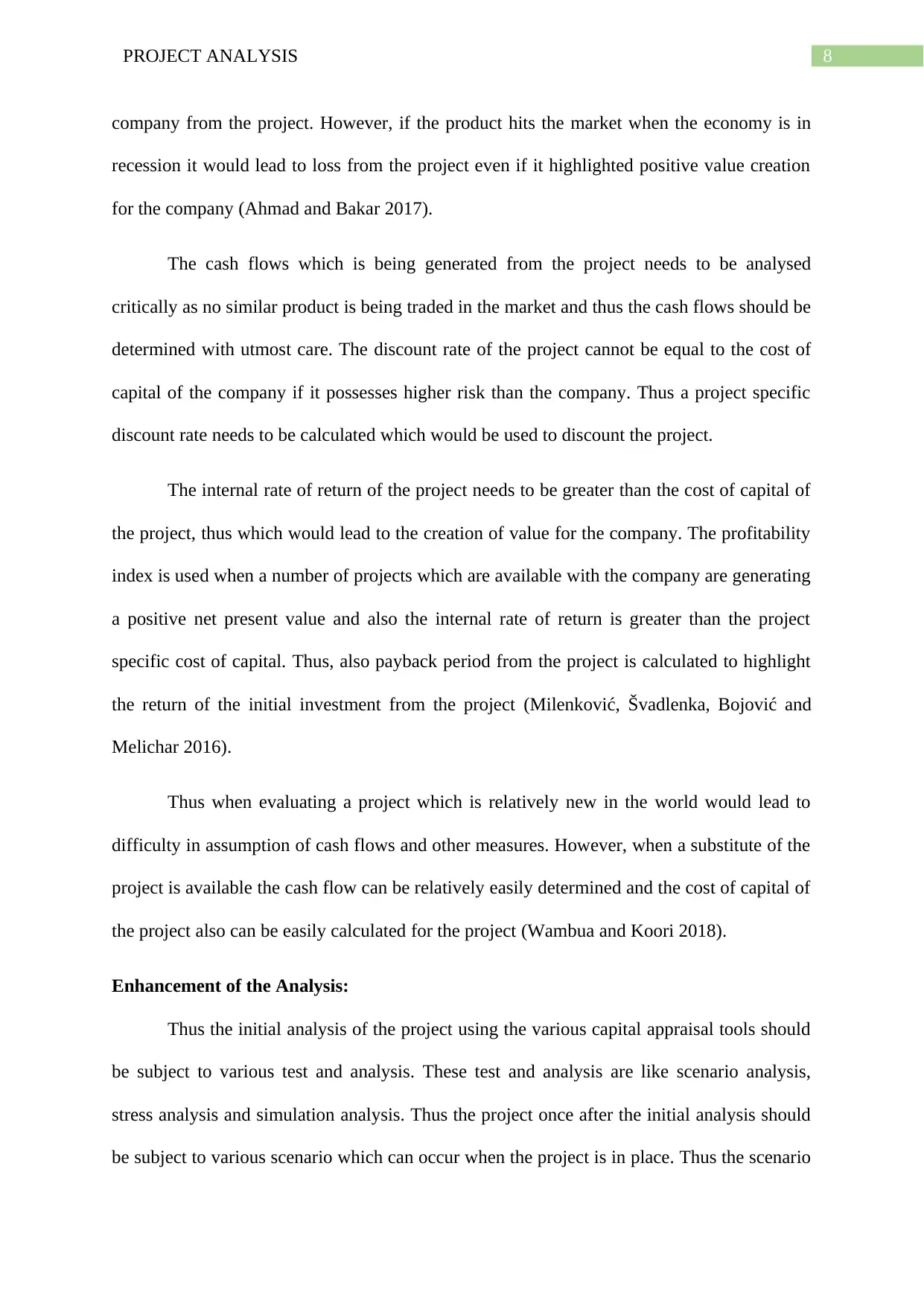
8PROJECT ANALYSIS
company from the project. However, if the product hits the market when the economy is in
recession it would lead to loss from the project even if it highlighted positive value creation
for the company (Ahmad and Bakar 2017).
The cash flows which is being generated from the project needs to be analysed
critically as no similar product is being traded in the market and thus the cash flows should be
determined with utmost care. The discount rate of the project cannot be equal to the cost of
capital of the company if it possesses higher risk than the company. Thus a project specific
discount rate needs to be calculated which would be used to discount the project.
The internal rate of return of the project needs to be greater than the cost of capital of
the project, thus which would lead to the creation of value for the company. The profitability
index is used when a number of projects which are available with the company are generating
a positive net present value and also the internal rate of return is greater than the project
specific cost of capital. Thus, also payback period from the project is calculated to highlight
the return of the initial investment from the project (Milenković, Švadlenka, Bojović and
Melichar 2016).
Thus when evaluating a project which is relatively new in the world would lead to
difficulty in assumption of cash flows and other measures. However, when a substitute of the
project is available the cash flow can be relatively easily determined and the cost of capital of
the project also can be easily calculated for the project (Wambua and Koori 2018).
Enhancement of the Analysis:
Thus the initial analysis of the project using the various capital appraisal tools should
be subject to various test and analysis. These test and analysis are like scenario analysis,
stress analysis and simulation analysis. Thus the project once after the initial analysis should
be subject to various scenario which can occur when the project is in place. Thus the scenario
company from the project. However, if the product hits the market when the economy is in
recession it would lead to loss from the project even if it highlighted positive value creation
for the company (Ahmad and Bakar 2017).
The cash flows which is being generated from the project needs to be analysed
critically as no similar product is being traded in the market and thus the cash flows should be
determined with utmost care. The discount rate of the project cannot be equal to the cost of
capital of the company if it possesses higher risk than the company. Thus a project specific
discount rate needs to be calculated which would be used to discount the project.
The internal rate of return of the project needs to be greater than the cost of capital of
the project, thus which would lead to the creation of value for the company. The profitability
index is used when a number of projects which are available with the company are generating
a positive net present value and also the internal rate of return is greater than the project
specific cost of capital. Thus, also payback period from the project is calculated to highlight
the return of the initial investment from the project (Milenković, Švadlenka, Bojović and
Melichar 2016).
Thus when evaluating a project which is relatively new in the world would lead to
difficulty in assumption of cash flows and other measures. However, when a substitute of the
project is available the cash flow can be relatively easily determined and the cost of capital of
the project also can be easily calculated for the project (Wambua and Koori 2018).
Enhancement of the Analysis:
Thus the initial analysis of the project using the various capital appraisal tools should
be subject to various test and analysis. These test and analysis are like scenario analysis,
stress analysis and simulation analysis. Thus the project once after the initial analysis should
be subject to various scenario which can occur when the project is in place. Thus the scenario
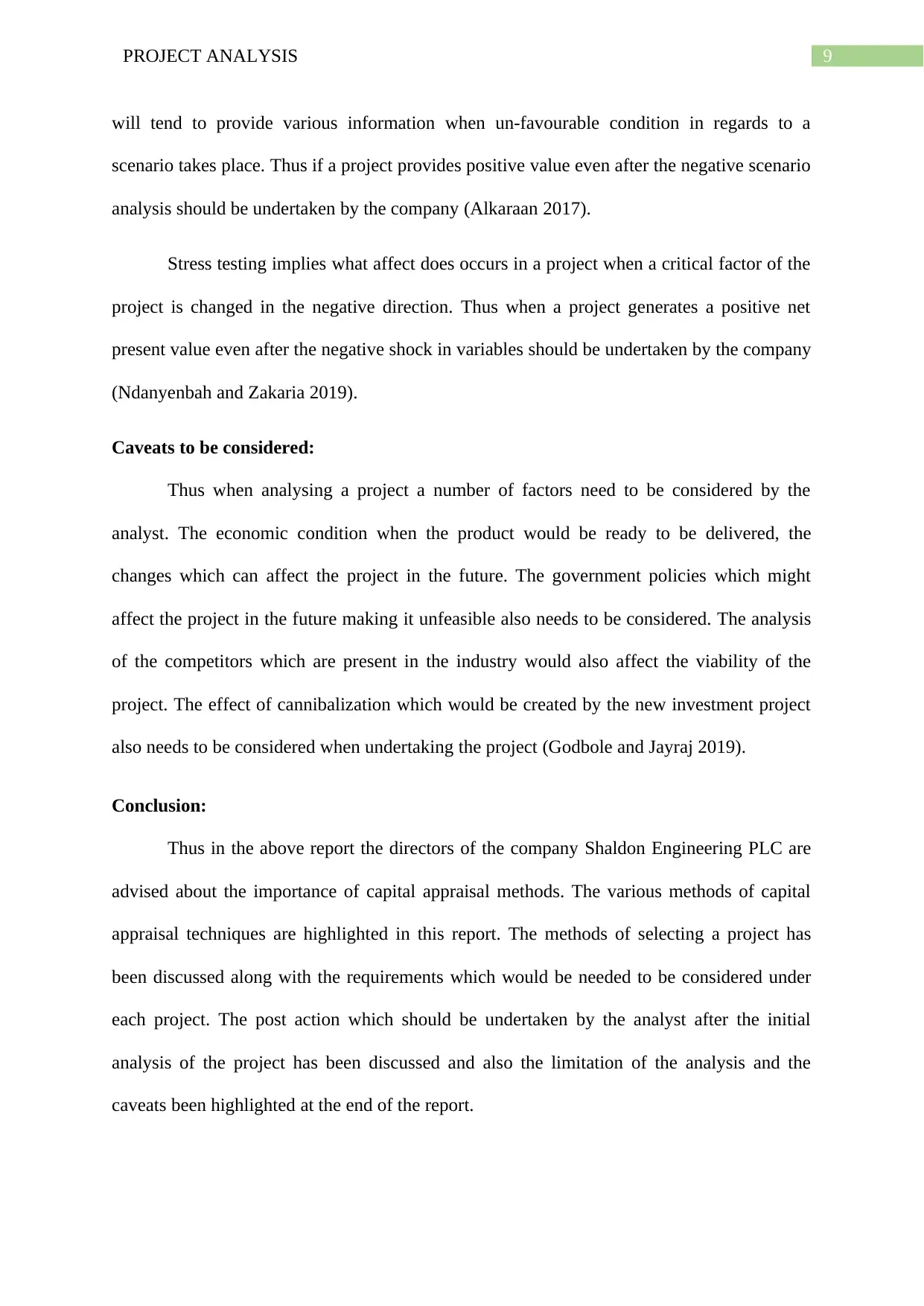
9PROJECT ANALYSIS
will tend to provide various information when un-favourable condition in regards to a
scenario takes place. Thus if a project provides positive value even after the negative scenario
analysis should be undertaken by the company (Alkaraan 2017).
Stress testing implies what affect does occurs in a project when a critical factor of the
project is changed in the negative direction. Thus when a project generates a positive net
present value even after the negative shock in variables should be undertaken by the company
(Ndanyenbah and Zakaria 2019).
Caveats to be considered:
Thus when analysing a project a number of factors need to be considered by the
analyst. The economic condition when the product would be ready to be delivered, the
changes which can affect the project in the future. The government policies which might
affect the project in the future making it unfeasible also needs to be considered. The analysis
of the competitors which are present in the industry would also affect the viability of the
project. The effect of cannibalization which would be created by the new investment project
also needs to be considered when undertaking the project (Godbole and Jayraj 2019).
Conclusion:
Thus in the above report the directors of the company Shaldon Engineering PLC are
advised about the importance of capital appraisal methods. The various methods of capital
appraisal techniques are highlighted in this report. The methods of selecting a project has
been discussed along with the requirements which would be needed to be considered under
each project. The post action which should be undertaken by the analyst after the initial
analysis of the project has been discussed and also the limitation of the analysis and the
caveats been highlighted at the end of the report.
will tend to provide various information when un-favourable condition in regards to a
scenario takes place. Thus if a project provides positive value even after the negative scenario
analysis should be undertaken by the company (Alkaraan 2017).
Stress testing implies what affect does occurs in a project when a critical factor of the
project is changed in the negative direction. Thus when a project generates a positive net
present value even after the negative shock in variables should be undertaken by the company
(Ndanyenbah and Zakaria 2019).
Caveats to be considered:
Thus when analysing a project a number of factors need to be considered by the
analyst. The economic condition when the product would be ready to be delivered, the
changes which can affect the project in the future. The government policies which might
affect the project in the future making it unfeasible also needs to be considered. The analysis
of the competitors which are present in the industry would also affect the viability of the
project. The effect of cannibalization which would be created by the new investment project
also needs to be considered when undertaking the project (Godbole and Jayraj 2019).
Conclusion:
Thus in the above report the directors of the company Shaldon Engineering PLC are
advised about the importance of capital appraisal methods. The various methods of capital
appraisal techniques are highlighted in this report. The methods of selecting a project has
been discussed along with the requirements which would be needed to be considered under
each project. The post action which should be undertaken by the analyst after the initial
analysis of the project has been discussed and also the limitation of the analysis and the
caveats been highlighted at the end of the report.
⊘ This is a preview!⊘
Do you want full access?
Subscribe today to unlock all pages.

Trusted by 1+ million students worldwide
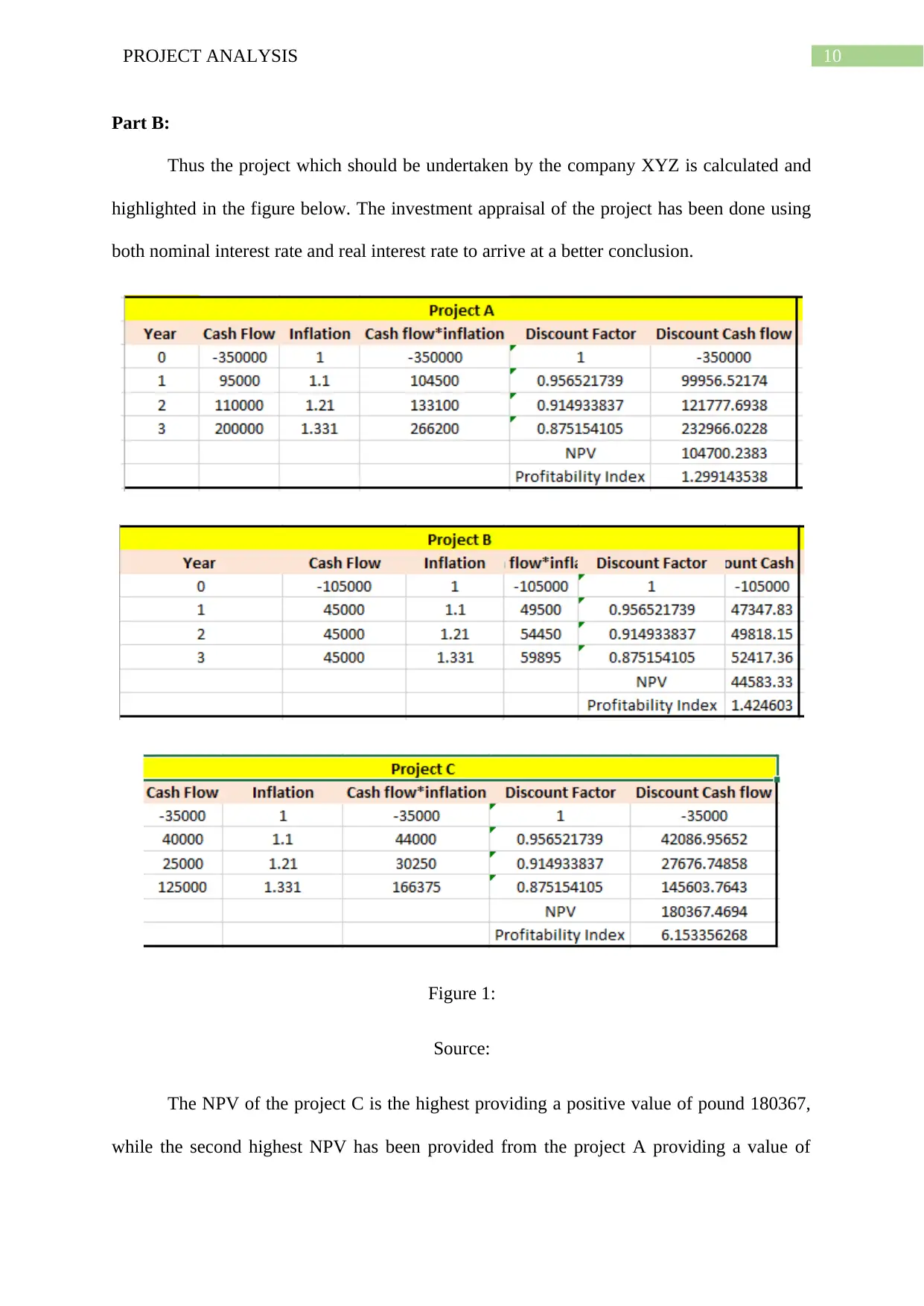
10PROJECT ANALYSIS
Part B:
Thus the project which should be undertaken by the company XYZ is calculated and
highlighted in the figure below. The investment appraisal of the project has been done using
both nominal interest rate and real interest rate to arrive at a better conclusion.
Figure 1:
Source:
The NPV of the project C is the highest providing a positive value of pound 180367,
while the second highest NPV has been provided from the project A providing a value of
Part B:
Thus the project which should be undertaken by the company XYZ is calculated and
highlighted in the figure below. The investment appraisal of the project has been done using
both nominal interest rate and real interest rate to arrive at a better conclusion.
Figure 1:
Source:
The NPV of the project C is the highest providing a positive value of pound 180367,
while the second highest NPV has been provided from the project A providing a value of
Paraphrase This Document
Need a fresh take? Get an instant paraphrase of this document with our AI Paraphraser
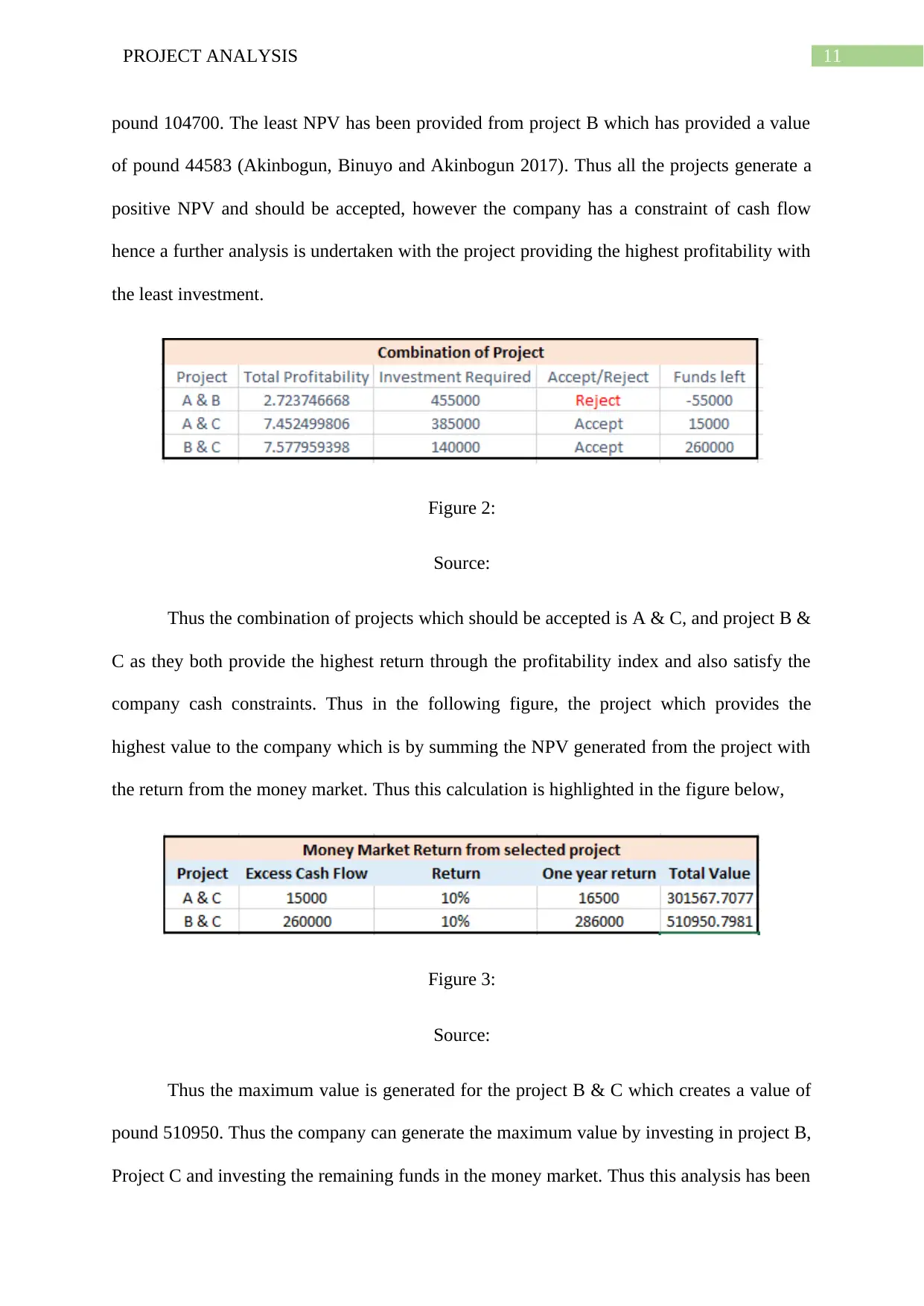
11PROJECT ANALYSIS
pound 104700. The least NPV has been provided from project B which has provided a value
of pound 44583 (Akinbogun, Binuyo and Akinbogun 2017). Thus all the projects generate a
positive NPV and should be accepted, however the company has a constraint of cash flow
hence a further analysis is undertaken with the project providing the highest profitability with
the least investment.
Figure 2:
Source:
Thus the combination of projects which should be accepted is A & C, and project B &
C as they both provide the highest return through the profitability index and also satisfy the
company cash constraints. Thus in the following figure, the project which provides the
highest value to the company which is by summing the NPV generated from the project with
the return from the money market. Thus this calculation is highlighted in the figure below,
Figure 3:
Source:
Thus the maximum value is generated for the project B & C which creates a value of
pound 510950. Thus the company can generate the maximum value by investing in project B,
Project C and investing the remaining funds in the money market. Thus this analysis has been
pound 104700. The least NPV has been provided from project B which has provided a value
of pound 44583 (Akinbogun, Binuyo and Akinbogun 2017). Thus all the projects generate a
positive NPV and should be accepted, however the company has a constraint of cash flow
hence a further analysis is undertaken with the project providing the highest profitability with
the least investment.
Figure 2:
Source:
Thus the combination of projects which should be accepted is A & C, and project B &
C as they both provide the highest return through the profitability index and also satisfy the
company cash constraints. Thus in the following figure, the project which provides the
highest value to the company which is by summing the NPV generated from the project with
the return from the money market. Thus this calculation is highlighted in the figure below,
Figure 3:
Source:
Thus the maximum value is generated for the project B & C which creates a value of
pound 510950. Thus the company can generate the maximum value by investing in project B,
Project C and investing the remaining funds in the money market. Thus this analysis has been
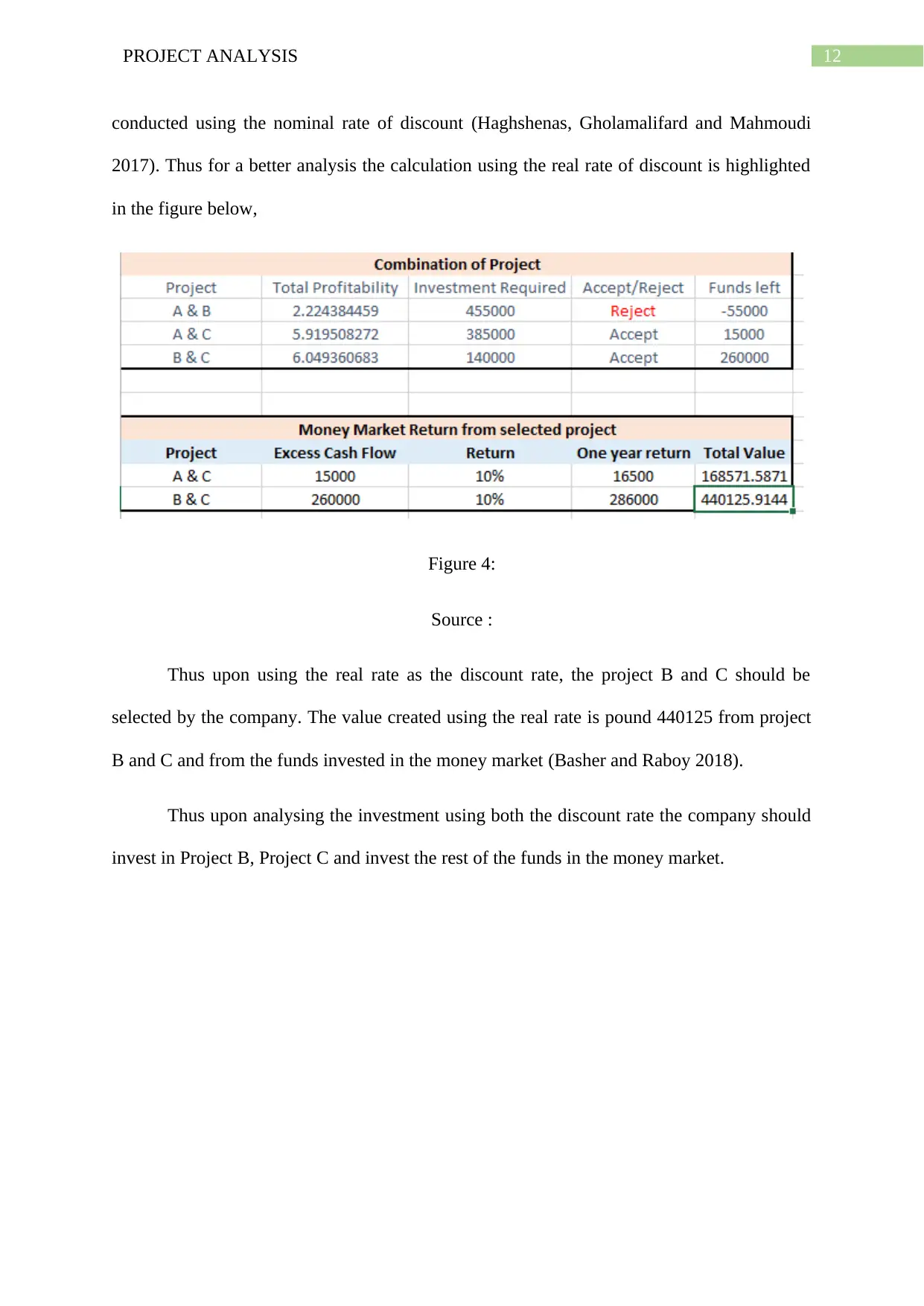
12PROJECT ANALYSIS
conducted using the nominal rate of discount (Haghshenas, Gholamalifard and Mahmoudi
2017). Thus for a better analysis the calculation using the real rate of discount is highlighted
in the figure below,
Figure 4:
Source :
Thus upon using the real rate as the discount rate, the project B and C should be
selected by the company. The value created using the real rate is pound 440125 from project
B and C and from the funds invested in the money market (Basher and Raboy 2018).
Thus upon analysing the investment using both the discount rate the company should
invest in Project B, Project C and invest the rest of the funds in the money market.
conducted using the nominal rate of discount (Haghshenas, Gholamalifard and Mahmoudi
2017). Thus for a better analysis the calculation using the real rate of discount is highlighted
in the figure below,
Figure 4:
Source :
Thus upon using the real rate as the discount rate, the project B and C should be
selected by the company. The value created using the real rate is pound 440125 from project
B and C and from the funds invested in the money market (Basher and Raboy 2018).
Thus upon analysing the investment using both the discount rate the company should
invest in Project B, Project C and invest the rest of the funds in the money market.
⊘ This is a preview!⊘
Do you want full access?
Subscribe today to unlock all pages.

Trusted by 1+ million students worldwide
1 out of 15
Related Documents
Your All-in-One AI-Powered Toolkit for Academic Success.
+13062052269
info@desklib.com
Available 24*7 on WhatsApp / Email
![[object Object]](/_next/static/media/star-bottom.7253800d.svg)
Unlock your academic potential
Copyright © 2020–2025 A2Z Services. All Rights Reserved. Developed and managed by ZUCOL.


